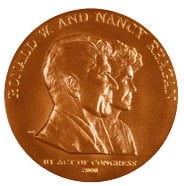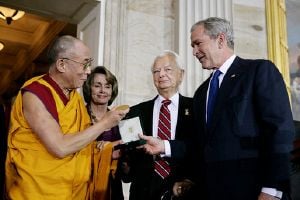Congressional Gold Medal

A Congressional Gold Medal is an award bestowed by the United States Congress and is, along with the Presidential Medal of Freedom, the highest civilian award in the United States. The decoration is awarded to an individual who performs an outstanding deed or act of service to the security, prosperity, and national interest of the United States. American citizenship is not a requirement.
The Gold Medal and the Presidential Medal of Freedom are generally considered to carry the same level of prestige (though significantly fewer Gold Medals have been awarded). The chief difference between the two is that the Medal of Freedom is personally awarded by the President of the United States (executive branch), and Congressional Gold Medals are awarded by acts of the Congress (legislative branch).
Per committee rules, legislation bestowing a Congressional Gold Medal upon a recipient must be co-sponsored by two-thirds of the membership of both the House of Representatives and the Senate before their respective committees will consider it.
A Congressional Gold Medal is a completely separate decoration from the Medal of Honor, which is a military award for extreme bravery in action. Another similarly named decoration is the Congressional Space Medal of Honor, presented by NASA for extraordinary accomplishment to the mission of United States space exploration.
Design
A Congressional Gold Medal is created by the United States Mint to specifically commemorate the person and achievement for which the medal is awarded. Each medal is therefore different in appearance, and there is no standard design for a Congressional Gold Medal. Congressional Gold Medals are also considered "non-portable," meaning that they are not meant to be worn on a uniform or other clothing, but rather displayed much like a trophy. Often, bronze versions of the medals are struck for sale.
Mint engravers prepare a series of sketches of possible designs for consideration and comment by the Commission of Fine Arts and subsequently the Secretary of the Treasury, who makes the final decision on the medalâs design. Once the Secretary of the Treasury, in consultation with the honoreeâs family, has made a selection, the design is sculptured, a dye is made, and the medal is struck at the Philadelphia Mint.[1]
History
On March 25, 1776, George Washington, commander of the Continental Army, was awarded the first Congressional Gold Medal from The Second Continental Congress for his "wise and spirited conduct" in bringing about British evacuation of Boston. During the next 12 years, the Continental Congress authorized an additional six gold medals for Revolutionary military and naval leaders.
In 1777, Major General Horatio Gates was recognized for his âbrave and successful effortsâ in bringing about the surrender of the British Army at Saratoga. Two years later, a similar honor was bestowed upon Major General Anthony Wayne in 1779 for his courageous assault on the British at Stony Point, New York. A gold medal was also given to Major Henry Lee in commemoration of the skill and bravery he exhibited against the British at Paulus Hook, New Jersey. Brigadier General Daniel Morgan and Major General Nathaniel Greene were praised for their gallant efforts in South Carolina during 1781. Six years later, John Paul Jones was similarly honored for his "valor and brilliant services" in capturing the Serapis.[1]
While the Continental Congress was prompt in approving each of these medals, those responsible for carrying out the wishes of Congress were not so prompt. Because of its close ties with France, Congress turned to Paris for advice and assistance in having the medals struck. Unfortunately, Congressâ preoccupation with the American Revolution, together with the lengthy and complicated procedures which had to be followed in Paris, produced long delays. Thomas Jefferson was not able to present Washington his gold medal until March 21, 1790, some 14 years after it had been approved. At the same time, Washington received a mahogany box containing a number of other gold medals ordered by Congress. Soon thereafter, these medals were transmitted by the former President to the various recipients. The gold medal conferred upon Major Henry âLight Horse Harryâ Lee was the first to be struck in this country.[1]
Since the American Revolution Congress has commissioned gold medals as its highest expression of national appreciation for distinguished achievements and contributions. Each medal honors a particular individual, institution, or event.
Following the ratification of the United States Constitution, the first gold medal authorized by Congress was given to Captain Thomas Truxtun in 1800 for action between the United States frigate Constellation and the French ship La Vengeance. In 1805, Commodore Edward Preble received a gold medal for gallantry and good conduct during the War with Tripoli.
Subsequently, Congress commissioned 27 gold medals for notable victories and achievements in the War of 1812. This was more than four times as many as it had given during the American Revolution.
Gold medals would continue to be awarded for military achievements until the American Civil War, but with far less frequency.
The gold medal Congress approved on February 22, 1816, honoring Captain James Biddleâs "gallantry" in capturing the British sloop-of-war Penguin was the final naval award of this character awarded by Congress until World War II.

In 1858, Dr. Frederick A. Rose, an assistant-surgeon in the British Navy, was recognized for his kindness and humanity to sick American seamen aboard the U.S. steamer Susquehannah, whose crew had been stricken with yellow fever. With this action Congress broke with its tradition of only honoring heroism associated with the actions of American military or naval personnel.[1]
The scope of those who can receive the medal now includes actors, authors, entertainers, musicians, pioneers in aeronautics and space, explorers, lifesavers, notables in science and medicine, athletes, humanitarians, public servants, and foreign recipients.[2]
Among the awardâs non-American recipients are Nelson Mandela, Mother Teresa, British Prime Minister Winston Churchill, British Prime Minister Tony Blair and former Russian dissident and Israeli Cabinet member Natan Sharansky.
Multiple winners
Major General Winfield Scott (1814, 1848) and John Horn, Jr. (1874, 1904) won the award twice while Major General Zachary Taylor was awarded this special distinction three times: in 1846, 1847, and 1848.[3]
New Medal
In 1861 Congress established the first permanent American military decoration with creation of the Medal of Honor. This award marked the beginning of a formalized policy by the United States of awarding military decorations. Although this medal was also to be presented in the name of the Congress of the United States and today is often referred to as the Congressional Medal of Honor, the regulations for awarding the Medal of Honor have from the beginning been the responsibility of the armed services. There is a clear distinction between the Medal of Honor, which is a military award, and Congressional Gold Medals, which are authorized by Congress to honor particular individuals and events.
During the American Civil War, more than 1500 Americans were awarded the Medal of Honor, but only one individualâUlysses S. Grantâreceived a Congressional Gold Medal. Thirty-five years were to pass before Congress would bestow the Gold Medal on another American military leader.[1]
Design and Casting
After a Congressional Gold Medal bill has been approved by both houses of Congress and signed into law by the President, officials of the U.S. Mint meet with the sponsors of the legislation and members of the honoree's family to discuss possible designs for the medal.
A series of designs and sketches are then produced for consideration and comment by the [[Commission of Fine Arts]], and subsequently the Secretary of the Treasury, who makes the final decision on the design.
Once a design is agreed upon and approved the design is sculpted, a die is made and the medal is struck at the Philadelphia Mint.
Notes
- â 1.0 1.1 1.2 1.3 1.4 CRS Report for Congress "Congressional Gold Medals, 1776-2008" Senate.gov. Retrieved January 25, 2009.
- â Congressional Research Service, Congressional Gold Medal Recipients Retrieved February 22, 2009.
- â Official Site Congressionalgoldmedal.com. Retrieved January 26, 2009.
ReferencesISBN links support NWE through referral fees
- CRS Report for Congress "Congressional Gold Medals, 1776-2008" Senate.gov. Retrieved February 22, 2009.
- Stathis, Stephen W. 2002. Congressional Gold Medals, 1776-2002. New York: Novinka Books. ISBN 1590335147
- Official site of Congressional Gold Medal Congressionalgoldmedal.com. Retrieved February 22, 2009.
External links
All links retrieved March 20, 2017.
- CRS Report for Congress Senate.gov.
- Congressional Gold Medal Nndb.com.
- Barrett, Ted. 2005. House votes to limit congressional gold medal awards Edition.cnn.com.
- Tony Blair's Address to Congress Accepting Congressional Gold Medal Americanrhetoric.com.
Credits
New World Encyclopedia writers and editors rewrote and completed the Wikipedia article in accordance with New World Encyclopedia standards. This article abides by terms of the Creative Commons CC-by-sa 3.0 License (CC-by-sa), which may be used and disseminated with proper attribution. Credit is due under the terms of this license that can reference both the New World Encyclopedia contributors and the selfless volunteer contributors of the Wikimedia Foundation. To cite this article click here for a list of acceptable citing formats.The history of earlier contributions by wikipedians is accessible to researchers here:
The history of this article since it was imported to New World Encyclopedia:
Note: Some restrictions may apply to use of individual images which are separately licensed.